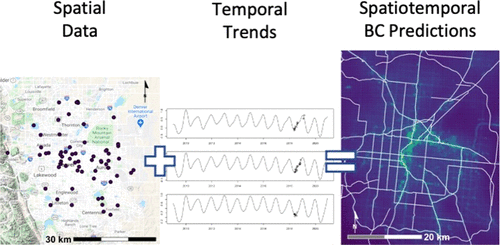当前位置:
X-MOL 学术
›
Environ. Sci. Technol.
›
论文详情
Our official English website, www.x-mol.net, welcomes your feedback! (Note: you will need to create a separate account there.)
A Spatiotemporal Prediction Model for Black Carbon in the Denver Metropolitan Area, 2009–2020
Environmental Science & Technology ( IF 11.4 ) Pub Date : 2021-02-17 , DOI: 10.1021/acs.est.0c06451 Sheena E Martenies 1, 2 , Joshua P Keller 3 , Sherry WeMott 2 , Grace Kuiper 2 , Zev Ross 4 , William B Allshouse 5 , John L Adgate 5 , Anne P Starling 6, 7 , Dana Dabelea 6, 7, 8 , Sheryl Magzamen 2, 6
Environmental Science & Technology ( IF 11.4 ) Pub Date : 2021-02-17 , DOI: 10.1021/acs.est.0c06451 Sheena E Martenies 1, 2 , Joshua P Keller 3 , Sherry WeMott 2 , Grace Kuiper 2 , Zev Ross 4 , William B Allshouse 5 , John L Adgate 5 , Anne P Starling 6, 7 , Dana Dabelea 6, 7, 8 , Sheryl Magzamen 2, 6
Affiliation

|
Studies on health effects of air pollution from local sources require exposure assessments that capture spatial and temporal trends. To facilitate intraurban studies in Denver, Colorado, we developed a spatiotemporal prediction model for black carbon (BC). To inform our model, we collected more than 700 weekly BC samples using personal air samplers from 2018 to 2020. The model incorporated spatial and spatiotemporal predictors and smoothed time trends to generate point-level weekly predictions of BC concentrations for the years 2009–2020. Our results indicate that our model reliably predicted weekly BC concentrations across the region during the year in which we collected data. We achieved a 10-fold cross-validation R2 of 0.83 and a root-mean-square error of 0.15 μg/m3 for weekly BC concentrations predicted at our sampling locations. Predicted concentrations displayed expected temporal trends, with the highest concentrations predicted during winter months. Thus, our prediction model improves on typical land use regression models that generally only capture spatial gradients. However, our model is limited by a lack of long-term BC monitoring data for full validation of historical predictions. BC predictions from the weekly spatiotemporal model will be used in traffic-related air pollution exposure-disease associations more precisely than previous models for the region have allowed.
中文翻译:

2009-2020 年丹佛都会区黑碳时空预测模型
对当地空气污染对健康影响的研究需要捕捉空间和时间趋势的暴露评估。为了促进科罗拉多州丹佛市的城市内研究,我们开发了黑碳 (BC) 的时空预测模型。为了为我们的模型提供信息,我们使用个人空气采样器从 2018 年到 2020 年每周收集了 700 多个 BC 样本。该模型结合了空间和时空预测因子并平滑了时间趋势,以生成 2009-2020 年 BC 浓度的点级每周预测。我们的结果表明,我们的模型可靠地预测了我们收集数据的一年中该地区每周的 BC 浓度。我们实现了 0.83 的 10 倍交叉验证R 2和 0.15 μg/m 3的均方根误差在我们的采样位置预测的每周 BC 浓度。预测浓度显示出预期的时间趋势,在冬季月份预测的浓度最高。因此,我们的预测模型改进了通常仅捕获空间梯度的典型土地利用回归模型。然而,我们的模型受限于缺乏用于全面验证历史预测的长期 BC 监测数据。BC 每周时空模型的预测将用于与交通相关的空气污染暴露-疾病关联,比该地区以前的模型所允许的更精确。
更新日期:2021-03-02
中文翻译:

2009-2020 年丹佛都会区黑碳时空预测模型
对当地空气污染对健康影响的研究需要捕捉空间和时间趋势的暴露评估。为了促进科罗拉多州丹佛市的城市内研究,我们开发了黑碳 (BC) 的时空预测模型。为了为我们的模型提供信息,我们使用个人空气采样器从 2018 年到 2020 年每周收集了 700 多个 BC 样本。该模型结合了空间和时空预测因子并平滑了时间趋势,以生成 2009-2020 年 BC 浓度的点级每周预测。我们的结果表明,我们的模型可靠地预测了我们收集数据的一年中该地区每周的 BC 浓度。我们实现了 0.83 的 10 倍交叉验证R 2和 0.15 μg/m 3的均方根误差在我们的采样位置预测的每周 BC 浓度。预测浓度显示出预期的时间趋势,在冬季月份预测的浓度最高。因此,我们的预测模型改进了通常仅捕获空间梯度的典型土地利用回归模型。然而,我们的模型受限于缺乏用于全面验证历史预测的长期 BC 监测数据。BC 每周时空模型的预测将用于与交通相关的空气污染暴露-疾病关联,比该地区以前的模型所允许的更精确。


























 京公网安备 11010802027423号
京公网安备 11010802027423号